Many observers seem to assume blockchain technology is an immovable monolith. While such assumption does help when trying to explain how the technology works to the general public, this is not the case when describing the actual status of the technology.
Rapid and agile innovation is one of the core traits of blockchains, backed by impressive human talent with substantial financial resources, addressing not only some of its well-known limitations but also enhancing its core functionality. Blockchain technology is evolving rapidly and the best way to take stock, for now, it’s via frequent snapshots. In fact, keeping track of blockchain innovations could quickly become a full-time job. In any event, the monolith is not only moving. It is indeed flying at the speed of light.
Blockchains also come in different flavors, with more already in the production process. And differences between them are not minuscule in many cases. This in itself should prevent analysts and researchers from making sweeping generalizations about the technology.
For starters, the distinction between blockchains and distributed ledger technology (DLT) is essential. Blockchains are a subset of DLTs. That is, all blockchains are DLTs, but not all DLTs need to use blockchain technology. Defining a distributed ledger as a database running within a distributed or peer-to-peer network can help clarify this distinction. 1 A ledger is a database type used to record financial transactions. Not all databases are ledgers. A blockchain is a DLT that mathematically links records or blocks of data in sequential fashion using cryptographic tools.
As its first incarnation, Bitcoin is the vanilla flavor of all blockchains. Here I include the over 500 hundred altcoins that run on Bitcoin’s vanilla blockchain with modified source code, as well as the so-called colored coins. Many blockchain 101 blogs, videos and even MOOCs use the Bitcoin blockchain as the key example. Bitcoin is first and foremost a cryptocurrency. But not all blockchains need to issue cryptocurrencies to be operational.
The table below summarizes the various options, including examples for each of them.
DLT Typology
| DLT | Blockchain | |
|---|---|---|
| Cryptocurrency | IOTA | Bitcoin, Ethereum |
| No Cryptocurrency | Corda | Hyperledger Fabric |
Most are, however, sticking for the time being to blockchain technology. If we see the vanilla Bitcoin blockchain as blockchains 1.0, then Ethereum and others are the natural followers. And new platforms such as Neo, for example, seem to foreshadow the future of blockchains. Blockchains 3.0 will end up using advances in technology that are being developed at this very moment.
Nowadays, Bitcoin, Ethereum, and Hyperledger Fabric blockchains are the most popular and well-known platforms. The table below presents the various attributes of these platforms and highlights some of their differences.
Blockchain technology is a rapidly moving target permeated by continuous innovation. While it is difficult to predict how the technology will evolve in the next five years or so, it seems clear that blockchains are still in their infancy. Widespread adoption might only start in sustained fashion once it reaches a higher level of maturity. For now, the number of potential use cases is far more extensive than the number of actual projects on the ground.
Cheers, Raúl
Endnotes
| ⇧1 | A ledger is a database type used to record financial transactions. Not all databases are ledgers. |
|---|



Comments
One response to “Blockchain Technology is not a Monolith”